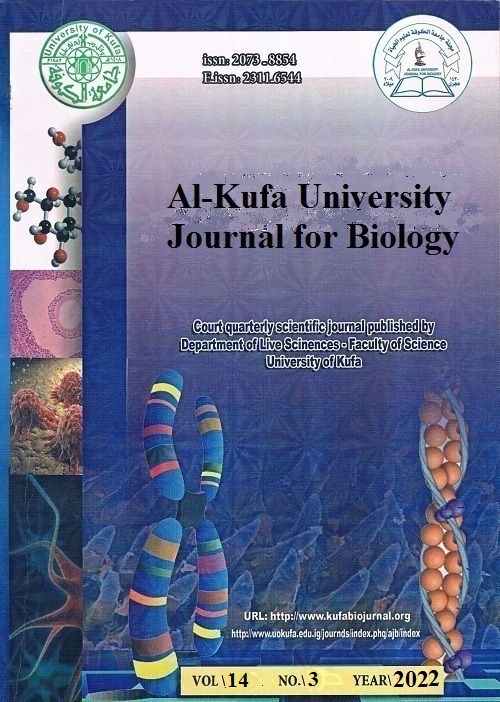Biological and inhibitory activity of carbon nanotubes against the biofilm produced by Enterobacteriaceae
DOI:
https://doi.org/10.36320/ajb/v14.i3.11151Keywords:
Enterobacteriaceae, carbon nanotubes, biofilm formationAbstract
Multiple drug resistance prompted researchers to investigate novel components that might effectively restrict the development of microorganisms, and carbon nanotubes were employed to suppress the biofilm in this study. Bacteria in a biofilm develop differently than bacteria in a planktonic environment. The antimicrobial test was performed using Perez and others' approach, the carbon nanotube test (0.05 percent, 0.02 percent, 0.01 percent ). The concentration was tested. In addition, Enterobacteriaceae reveals that the average inhibitory zone is 54 mm. In addition, pathogenic isolates could not form biofilms when exposed to carbon nanotubes. Klebsiella pneumonia had a maximum value of 0.426 nm and then dropped to 0.171 nm. The inhibitory impact of carbon- nanotube and the suppression of biofilm formation by pathogenic bacteria were discovered in this study
Downloads
References
Alcantar-Curiel, M. D. et al. Association of Antibiotic Resistance, Cell Adherence, and Biofilm Production with the Endemicity of Nosocomial Klebsiella pneumonia. BioMed research international 2018, 7012958 (2018). DOI: https://doi.org/10.1155/2018/7012958
Camper, A.K., McFeters, G.A., Characklis, W.G. and Jones, W.L. (1991) Growth kinetics of coliform bacteria under conditions relevant to drinking water distribution systems. Applied and Environmental Microbiology 57, 2233-2239. DOI: https://doi.org/10.1128/aem.57.8.2233-2239.1991
Greene, C., Vadlamudi, G., Newton, D., Foxman, B. & Xi, C. Te influence of biofilm formation and multidrug resistance on environmental survival of clinical and environmental isolates of Acinetobacter baumannii. American journal of infection control 44, e65–71 (2016). DOI: https://doi.org/10.1016/j.ajic.2015.12.012
Jackson, P.; Jacobsen, N.R.; Baun, A.; Birkedal, R.; Kühnel, D.; Jensen, K.A.; Vogel, U.; Wallin, H.Bioaccumulation, and ecotoxicity of carbon nanotubes. Chem. Cent. J. 2013, 7, 154. DOI: https://doi.org/10.1186/1752-153X-7-154
Kang, S.; Herzberg, M.; Rodrigues, D. F.; Elimelech, M. Antibacterial effects of carbon nanotubes: size does matter! Langmuir 2008, 24, 6409–6413.
Kang S, Herzberg M, Rodrigues DF, Elimelech M. 2008. Antibacterial effects of carbon nanotubes: size does matter! Langmuir. 24:6409–6413.
Kang S, Herzberg M, Rodrigues DF, Elimelech M. Antibacterial effects of carbon nanotubes: size does matter! Langmuir. 2008;24(13):6409–13. DOI: https://doi.org/10.1021/la800951v
Kallen, A.J., and A. Srinivasan. 2010. Current epidemiology of multidrug-resistant gram-negative bacilli in the DOI: https://doi.org/10.1086/655996
The United States. Infect. Control Hosp. Epidemiol. 31 Suppl 1: S51–S54.
Kaplan, J.B. 2011. Antibiotic-induced biofilm formation. Int. J. Artif. Organs. 34:737–751. DOI: https://doi.org/10.5301/ijao.5000027
Kolter R. and E. P. Greenberg, Microbial sciences—The superficial life of microbes, Nature, 2006, 441(7091), 300–302. DOI: https://doi.org/10.1038/441300a
Lawrence, J.R.; Waiser, M.J.; Swerhone, G.D.W.; Roy, J.; Tumber, V.; Paule, A.; Hitchcock, A.P.; Dynes, J.J.; Korber, D.R. Effects of fullerene (C60), multi-wall carbon nanotubes (MWCNT), single-wall carbon nanotubes (SWCNT) and hydroxyl and carboxyl modified single-wall carbon nanotubes on riverine microbial communities. Environ. Sci. Pollut. Res. 2016, 23, 10090–10102. DOI: https://doi.org/10.1007/s11356-016-6244-x
Magiorakos, A. P. et al. Infection prevention and control measures, and tools for preventing the entry of carbapenem-resistant Enterobacteriaceae into healthcare settings: guidance from the European Centre for Disease Prevention and Control. Antimicrobial resistance and infection control 6, 113 (2017). DOI: https://doi.org/10.1186/s13756-017-0259-z
Nielsen, D. W. et al. Te Impact of Media, Phylogenetic Classification, and E. coli Pathotypes on Biofilm Formation in Extraintestinal and Commensal E. coli From Humans and Animals. Frontiers in microbiology 9, 902 (2018). DOI: https://doi.org/10.3389/fmicb.2018.00902
Nigar Anzar a, Rahil Hasan a, Manshi Tyagi a, Neelam Yadav b, Jagriti Narang. Carbon nanotube - A review on Synthesis, Properties, and a plethora of Applications in the field of biomedical science. Sensors International 1 (2020) 100003. DOI: https://doi.org/10.1016/j.sintl.2020.100003
Ostria-Hernandez, M. L. et al. Nosocomial, Multidrug-Resistant Klebsiella pneumonia Strains Isolated from Mexico City Produce Robust Biofilms on Abiotic Surfaces but Not on Human Lung Cells. Microbial drug resistance (Larchmont, N.Y 24, 422–433 (2018). DOI: https://doi.org/10.1089/mdr.2017.0073
Peleg, A. Y. & Hooper, D. C. Hospital-acquired infections due to gram-negative bacteria. Te New England journal of medicine 362, 1804–1813 (2010). DOI: https://doi.org/10.1056/NEJMra0904124
Poole, K. Resistance to beta-lactam antibiotics. Cell Mol Life Sci 61, 2200–2223 (2004). DOI: https://doi.org/10.1007/s00018-004-4060-9
Rossi, E. et al. ―It’s a gut feeling‖ - Escherichia coli biofilm formation in the gastrointestinal tract environment. Critical reviews in microbiology 44, 1–30 (2017). DOI: https://doi.org/10.1080/1040841X.2017.1303660
Sicard, J. F., Le Bihan, G., Vogeleer, P., Jacques, M. & Harel, J. Interactions of Intestinal Bacteria with Components of the Intestinal Mucus. Frontiers in cellular and infection microbiology 7, 387 (2017). DOI: https://doi.org/10.3389/fcimb.2017.00387
Vuotto, C. et al. Biofilm formation and antibiotic resistance in Klebsiella pneumonia urinary strains. Journal of applied microbiology 123, 1003–1018 (2017). DOI: https://doi.org/10.1111/jam.13533
Yang, C.; Mamouni, J.; Tang, Y.; Yang, L. Antimicrobial activity of single-walled carbon nanotubes: Length effect. Langmuir 2010, 26, 16013–16019. DOI: https://doi.org/10.1021/la103110g
Zardini H.Z., M. Davarpanah, M. Shanbedi, A. Amiri, M. Maghrebi, L. Ebrahimi, Microbial toxicity of ethanolamines—multiwalled carbon nanotubes, J. Biomed. Mater. Res. (2014) 1774–1781. DOI: https://doi.org/10.1002/jbm.a.34846
Downloads
Published
How to Cite
Issue
Section
License
Copyright (c) 2022 Dina Hussein Hatif AL mansoori, Sahar M. Jawad, Firas Shawkat Al Bayati

This work is licensed under a Creative Commons Attribution 4.0 International License.
which allows users to copy, create extracts, abstracts, and new works from the Article, alter and revise the Article, and make commercial use of the Article (including reuse and/or resale of the Article by commercial entities), provided the user gives appropriate credit (with a link to the formal publication through the relevant DOI), provides a link to the license, indicates if changes were made and the licensor is not represented as endorsing the use made of the work.












